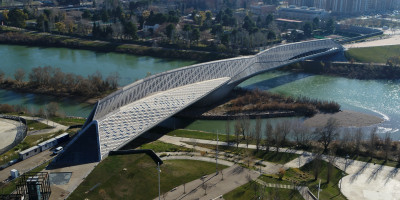More than 35 years after it opened, the site of the Halles de Paris had to be restructured and modernised because of its increasing daily attendance and because of new fire safety standards.
An important part of the renovation concerns the smoke control system of the ‘Forum des Halles’. Designed in the mid-1970s, it revolves around a single steel duct protected by a sprayed fire protection product and serving 16 compartments on 4 floors.
As part of the upgrade of the smoke control system made by SCFHP (Société Civile du Forum des Halles de Paris), the Safety Commission has asked for an assessment to be made of the behaviour of the fire dampers that will be installed on this system; these are intended to be used not only as fire dampers but also as smoke dampers.
The peculiarity of the system is that the same duct is used for smoke control and for space ventilation. The extraction in the compartment is provided by several sharp bends (elbows) connected to the main duct. These elbows are common to the smoke control system and to the space ventilation, and are protected by fire dampers, so that the fire does not spread from the duct to the non-affected compartments. However, the dampers of the damaged compartment should be kept open for the smoke to be extracted.
The scenario is therefore as follows:
- Under normal conditions, all the dampers are open to allow for space ventilation;
- In case of fire in a compartment, the dampers of this compartment are left open, and those corresponding to all other compartments are closed by remote control.
In this concept, the dampers should then work as smoke dampers. The SCFHP has commissioned an Efectis laboratory to conduct a feasibility study of the project to ensure that the use of the dampers will be as effective as the implementation of smoke dampers. The study first compared the fire and the smoke dampers from different manufacturers, and then estimated the fire behaviour of these elements in ‘inverted’ conditions, comparing them with those that have already been tested (in accordance with the prevailing testing methods).
These dampers have been tested for pressure loss under local conditions because of the considerable pressure losses in the ventilation system and the significant constraints in the duct (1500 Pa pressure in the peripheral duct under normal conditions, and 10,000 to 15,000 m3/h extraction flow rates during smoke extraction).
In collaboration with the manufacturers, minor changes have been made to the mechanisms of the dampers (with the removal of the fuse in particular) and specific fire resistance tests have been performed according to EN 1366-10, as this was considered the appropriate standard to judge the effectiveness of the smoke extraction.
Finally, Efectis issued an ‘expert judgment’ to assess the installation principles of these dampers on the existing ducts of the Forum.
The study has thus prevented the construction of a completely new smoke extraction system, while ensuring a safety level equivalent to that required by the regulations in force today


